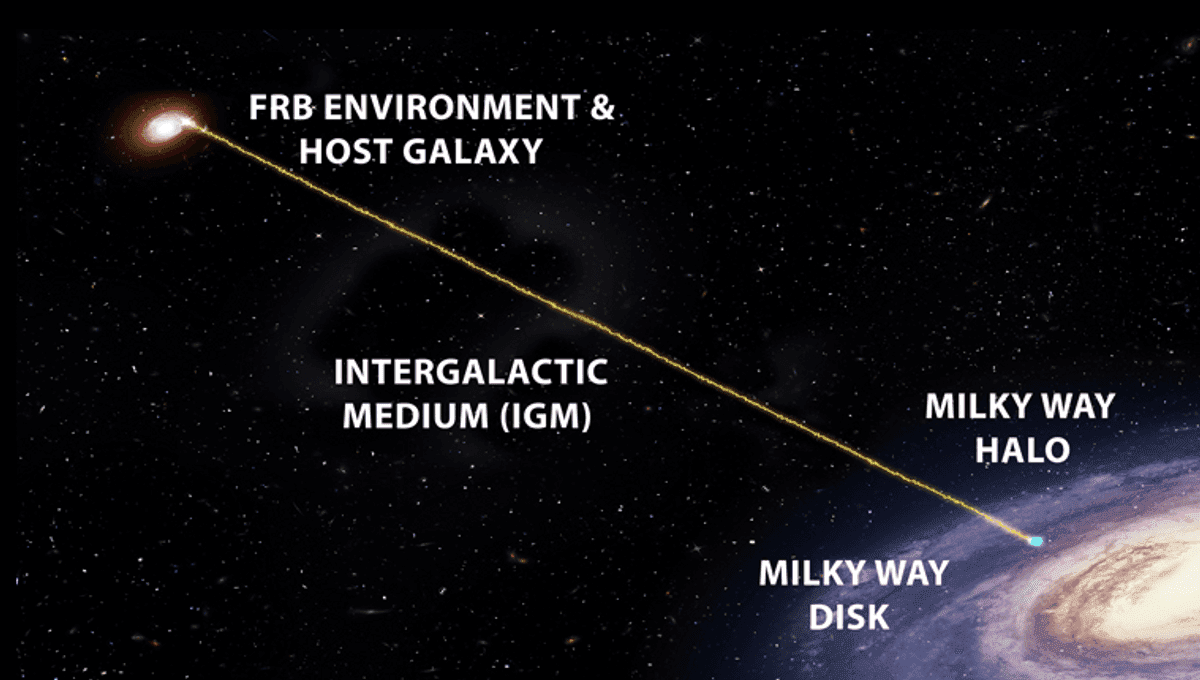
The halo surrounding the Milky Way contains gas as well as rare stars, but measuring that gas has proven difficult. The interference with short bursts of radio signals from distant galaxies offers astronomers a new solution.
The gas in the Milky Way’s halo is too sparse and hot to measure directly. However, it interferes with radiation reaching us from greater distances. University of Toronto PhD student Amanda Cook and Professor Bryan Gaensler realized that while we still don’t really understand the cause of Fast Radio Bursts (FRBs), their specific features make them perfect for measuring the halo gas. The results have been published in a new study.
Every FRB occurs over a wide range of radio frequencies, but they do not all arrive at once. It’s very unlikely the delay between the low and high frequencies reflects the time they were emitted. We know that electromagnetic radiation, radio waves included, slows down when passing through gas, and that high frequencies are slowed more than low. The thicker the gas, the more the radiation slows down.
Consequently, the gap between different frequencies serves as a measure of the amount of gas the radio waves have traversed. The spread is known as dispersion, or more colloquially, “smearing”.
“Using smearing to study the universe is like using your home heating bill to work out what the weather must have been like over the winter,” Cook said in a statement. “In the same way that your heating bill tells you whether it was a harsh winter or a mild winter – but not what the temperature was like on any individual date – the smearing that we see allows us to infer the total amount of material that the FRB signal has encountered on its journey from the FRB to Earth. It just can’t tell us how that material was distributed along the way.”
Confounding factors mean measurements based on one or two FRBs could be misleading. Cook and Gaensler took advantage of the fact the CHIME wide angle radio telescope has now detected hundreds of FRBs, of which 93 (four of them repeating) suited their needs.
Nevertheless, the pair and their co-authors ran into a problem. The gas the radio waves have passed through is not all in the Milky Way’s halo. Some of it is almost certainly in the galaxy in which the FRB occurred. There is also gas between galaxies, and while this may be much sparser, the distances between galaxies can be so vast the dispersion can add up on a long trip.
Extending Cook’s analogy, it’s like trying to work out how cold a single winter month was from gas bills that lasted much longer. If you can collect enough people’s bills that started and finished on different dates, you might be able to manage it, but you’d need some sophisticated statistical analysis to get there. A further complication is that the halo may not be perfectly spherical.
“It ended up being a lot more difficult than we thought,” Cook said. They benefited, however from one handy anomaly. One repeating FRB appears to be located in a globular cluster off M81, and therefore probably experiences minimal dispersion from its own galactic halo, and hasn’t had to pass through much interstellar material to get her.
The authors can’t reach a firm figure on average galactic halo density, but put the dispersion at 52-111 parsecs per cubic centimeter, the strange units used to measure it. That’s lower than most previous estimates made using other techniques.
Cook and Gaensler can see potential for teasing out the smearing – and therefore the gas density – of the other parts of the FRBs’ journeys, including in between galaxies.
The study is published open access in The Astrophysical Journal.
Source Link: Fast Radio Bursts Reveal The Milky Way's Halo Is Surprisingly Light